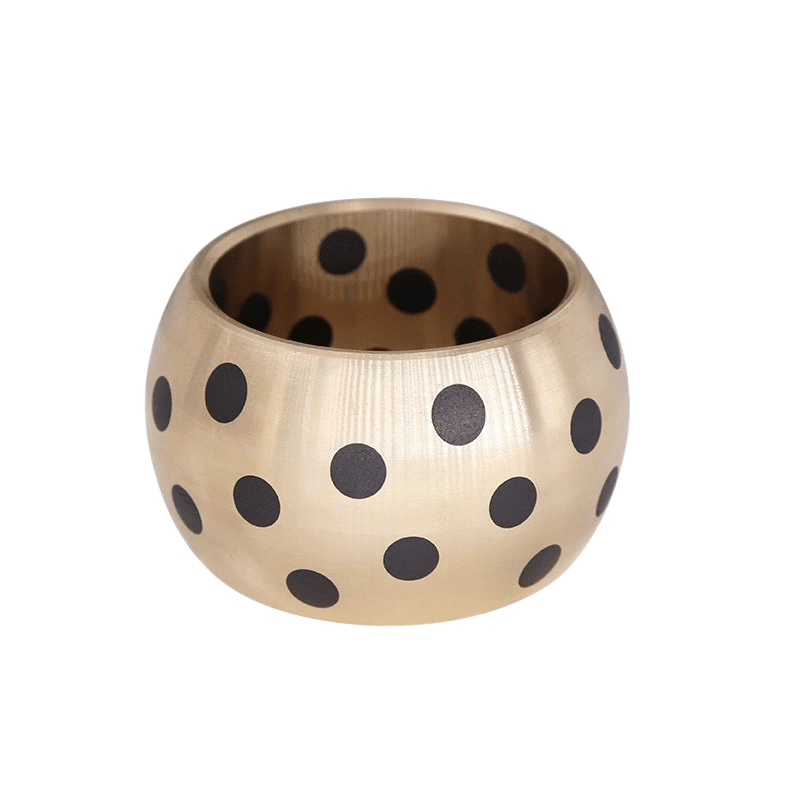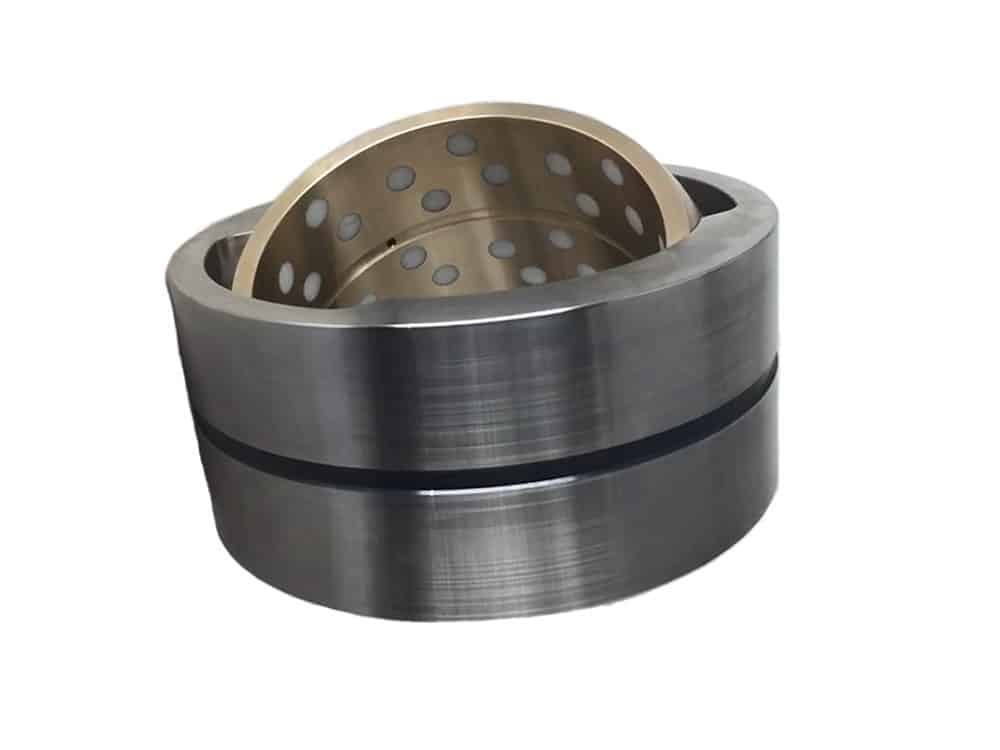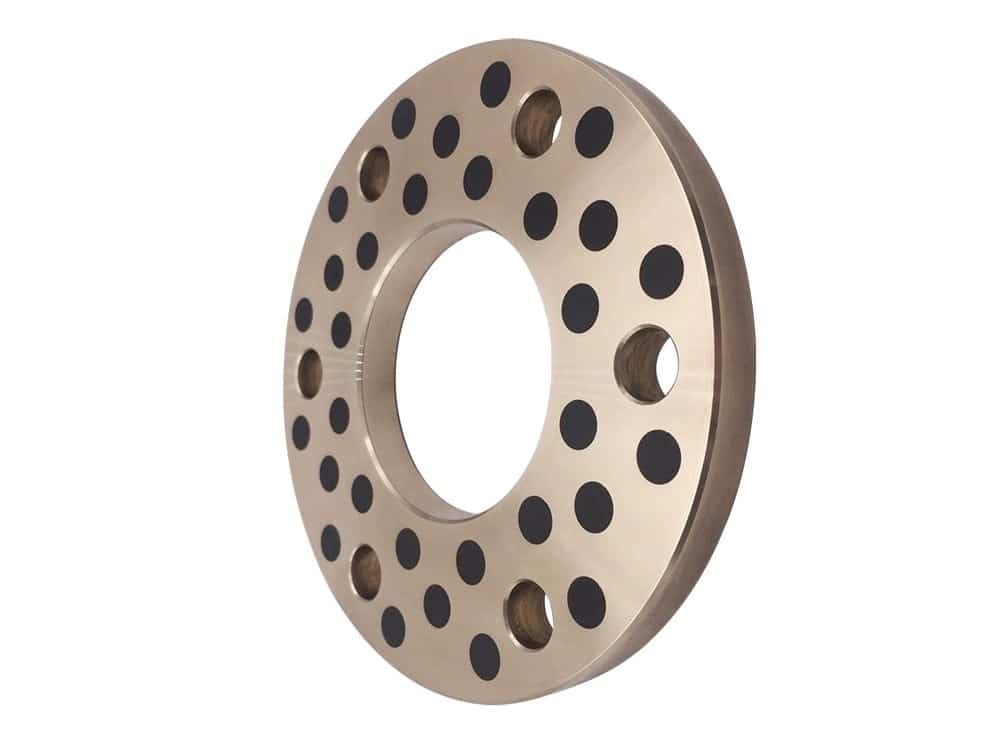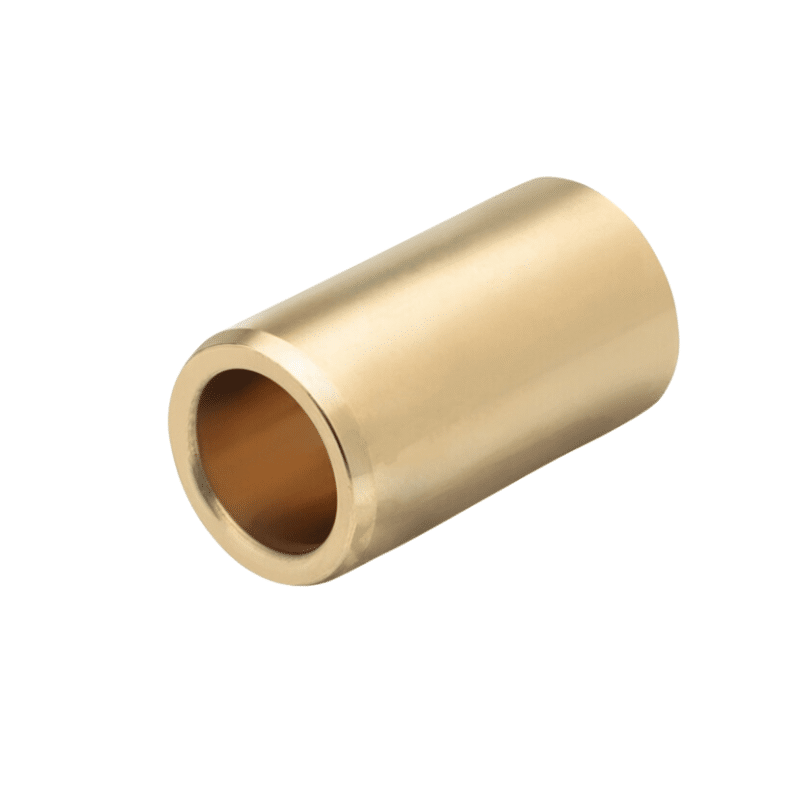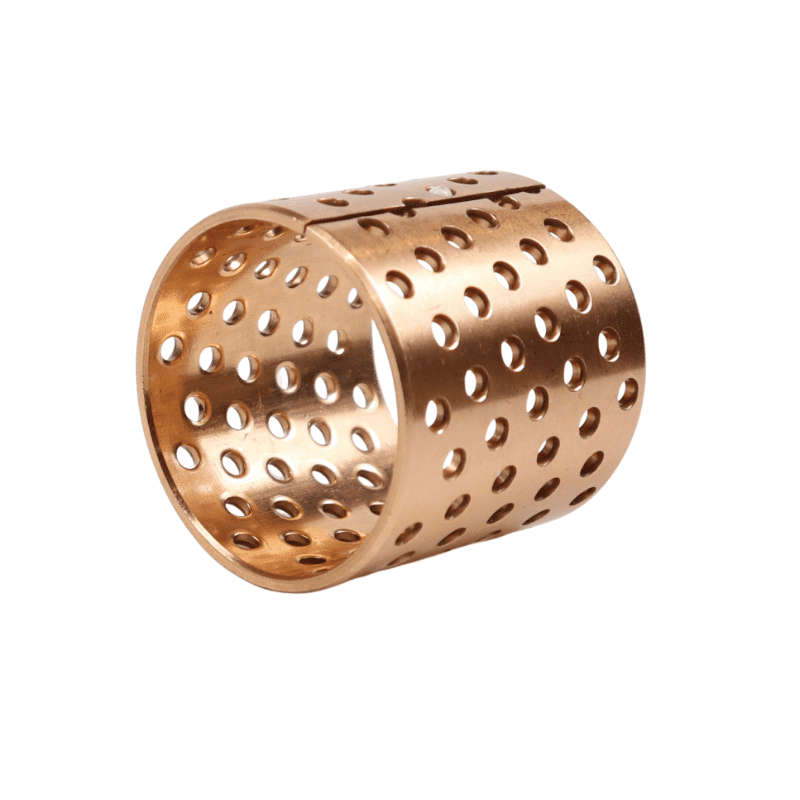Bronze Ball Bearing
Bronze Ball Bearing
Say goodbye to the hassle of frequent lubrication maintenance. Our self-lubricating technology ensures smooth operation and reduces wear and tear, extending the lifespan of your equipment. Experience uninterrupted productivity and cost savings as you bid farewell to the need for messy lubricants and time-consuming upkeep.
Manufacturing on Demand, alternative solutions
Bronze Ball Bearing
The bronze alloy base material, enriched with embedded graphite inlays, is ingeniously designed to enhance solid lubrication across mechanical parts. These graphite inlays, evenly distributed, are designated to cover 25-30% of the total sliding surface area, ensuring comprehensive lubrication across the entirety of the sliding area. This systematic distribution aids in reducing friction and wear, thus enhancing the part’s operational efficiency.
The base material itself exhibits a hardness ranging from 90 to 210 HB, which underscores its suitability for high-load applications where durability is paramount. To further optimize the running-in process and ensure a smoother start-up phase, the entire part is coated with a minimum of 30 micrometers of solid dry graphite lubricant. It’s crucial to note that all specified drawing dimensions are measured before the application of this coating, maintaining accuracy in the manufacturing process.
What specific applications or types of machinery do you plan to use these enhanced bronze alloy parts in? This will help tailor further details and suggestions relevant to your needs.
Bronze ball bearings are a critical component in many mechanical systems, offering a unique blend of durability, resistance to corrosion, and good mechanical properties. These bearings use balls made from bronze alloys, primarily to facilitate reduced friction and smooth movement between parts.
Composition and Properties
Bronze, primarily an alloy of copper and tin, may also include other elements like phosphorus, nickel, or aluminum to enhance specific properties. The high tin content in bronze improves its wear resistance and strength, making it suitable for heavy-load applications. Additionally, the natural corrosion resistance of bronze is beneficial for use in environments exposed to moisture and other corrosive elements.
Functionality of Bronze Ball Bearings
Bronze ball bearings function by allowing for smooth rotation and movement while minimizing friction between the moving parts of machinery. The bronze balls are encased between two rings, typically made of the same or a different metal, which help distribute the load evenly while the device operates. The hardness and smoothness of bronze reduce the amount of wear and tear on both the balls and the raceway.
The Rise of Oil-Free Graphite Self-Lubricating Bronze Ball Bearings: A Game Changer in Industrial Applications, Manufacturers of ball joints in bronze and bronze with inserts
Manufacturers of ball joints in bronze and bronze with inserts also produce spherical bearings and ball joints in steel and bronze combinations. These products can be either self-lubricating or require traditional lubrication. In addition to enabling rotation, these bearings facilitate the self-alignment of the shaft.
In the realm of industrial machinery, the quest for maintenance-free components has led to significant innovations, one of which is the oil-free graphite self-lubricating bearing. This type of bearing leverages the intrinsic properties of graphite to reduce friction and wear, eliminating the need for external lubrication. Made from a combination of graphite and metallic substrates like high-strength brass, tin bronze, or bronze balls, these bearings are revolutionizing the way industries approach machine design and maintenance.
The bronze alloy base material, enriched with embedded graphite inlays, is ingeniously designed to enhance solid lubrication across mechanical parts. These graphite inlays, evenly distributed, are designated to cover 25-30% of the total sliding surface area, ensuring comprehensive lubrication across the entirety of the sliding area. This systematic distribution aids in reducing friction and wear, thus enhancing the part’s operational efficiency.
The base material itself exhibits a hardness ranging from 90 to 210 HB, which underscores its suitability for high-load applications where durability is paramount. To further optimize the running-in process and ensure a smoother start-up phase, the entire part is coated with a minimum of 30 micrometers of solid dry graphite lubricant. It’s crucial to note that all specified drawing dimensions are measured before the application of this coating, maintaining accuracy in the manufacturing process.
What specific applications or types of machinery do you plan to use these enhanced bronze alloy parts in? This will help tailor further details and suggestions relevant to your needs.
Enhancing Mechanical Efficiency with Bronze Alloy and Graphite Inlay Ball Sleeves
In the realm of industrial machinery, the quest for materials that provide superior performance and durability is perpetual. A notable innovation in this field is the development of ball sleeves made from a bronze alloy base, featuring a sophisticated pattern of graphite inlays. This design is not only aesthetically pleasing but also significantly enhances the mechanical efficiency of various applications. Here’s an in-depth look at how this material technology works and its benefits.
Material Composition and Design
The ball sleeve is constructed from a bronze alloy, renowned for its durability and resistance to wear and corrosion. What sets this sleeve apart is the inclusion of graphite inlays, which are meticulously integrated into the alloy. These inlays are not randomly placed; they are strategically distributed to cover 25-20% of the total sliding surface area. This deliberate placement ensures that lubrication is evenly distributed across the entire sliding surface, enhancing the performance and longevity of the sleeve.
Enhanced Lubrication
One of the critical features of this ball sleeve is its self-lubricating design. The graphite inlays act as reservoirs for lubricants, which are crucial for reducing friction and wear. By facilitating solid lubrication across the sliding area, these sleeves significantly minimize the need for frequent maintenance and replacement. This design ensures that even under high-load conditions, the lubrication remains consistent and effective, preventing downtime and enhancing overall operational efficiency.
Material Properties
The hardness of the ball sleeve ranges from 90 to 210 HR, which indicates a very high level of durability. This hardness level is suitable for various industrial applications where mechanical stress and wear are common. The robust nature of the material ensures that the sleeve can withstand harsh conditions without degrading in quality or performance.
Manufacturing Precision
To optimize the running-in process, each part of the ball sleeve is coated with a minimum thickness of 20 micrometers of solid dry graphite lubricant. This coating not only enhances the initial lubrication but also contributes to a smoother and quicker running-in period, reducing initial wear and tear. It’s important to note that all drawing dimensions are specified before this coating is applied, ensuring that the final product meets all precise engineering requirements.
Application and Benefits
The innovative design of the bronze alloy ball sleeve with graphite inlays finds its application in various sectors, including automotive, aerospace, and heavy machinery. This technology is particularly beneficial in environments where operational efficiency, load capacity, and durability are critical. The self-lubricating feature reduces the need for additional lubrication maintenance, which can lead to cost savings and increased machine uptime.
In conclusion, the bronze alloy ball sleeve with graphite inlays represents a significant advancement in material engineering for industrial applications. Its superior lubrication capabilities and exceptional durability make it an ideal choice for enhancing the performance and longevity of machinery. As industries continue to seek solutions that reduce maintenance costs and improve efficiency, innovations like these play a crucial role in meeting these demands.
Graphite: The Cornerstone of Self-Lubrication
Graphite, an allotrope of carbon, is renowned for its exceptional self-lubricating capabilities and thermal stability. Its chemical stability makes it an ideal lubricant for various industrial applications. The layers of carbon atoms in graphite are loosely bonded, allowing them to slide over each other easily, which reduces friction significantly. This property is crucial in environments where traditional lubricants could falter.
High-Strength Brass: The Backbone of Durability
High-strength brass, a copper alloy typically containing zinc and other elements like lead and tin, is known for its robustness and hardness. These characteristics make it suitable for components like bearings that must withstand high loads. The resilience of high-strength brass helps in extending the lifespan of bearings under demanding operational conditions.
Tin Bronze: Champion of Corrosion Resistance
Tin bronze, an alloy of copper and tin, is celebrated for its excellent corrosion resistance and mechanical properties. This alloy is often used in the manufacture of ship components, chemical equipment, and bearings that require resistance to both corrosion and wear. Its durability makes tin bronze an ideal choice for harsh environments.
Bronze Balls: Enhancing Wear Resistance and Conductivity
Bronze balls serve as rolling elements in bearings, providing notable wear resistance and electrical conductivity. These balls are also versatile in other mechanical components, such as valves and pumps, where durability and reliability are paramount.
Advantages and Applications
The combination of these materials and components allows oil-free graphite self-lubricating bearings to operate without external lubrication, thus reducing maintenance costs and the risk of failures due to improper lubrication. These bearings are particularly suited for applications where regular maintenance is challenging or impossible, such as in extreme temperatures, highly polluted areas, or underwater environments.
Oil-free graphite self-lubricating bearings are not just a technological advancement; they are a paradigm shift in how we think about bearing design and maintenance. By eliminating the need for lubrication, these bearings offer a sustainable, efficient solution that meets the demands of modern industrial applications, making them a crucial component in the future of machinery and engineering.
Our client-focused approach throughout the company is fundamental to fulfilling our commitments to both quality and delivery times. We offer excellent lead times of 3-4 weeks.
Heavy-duty wear-resistant oil-free self-lubricating tin bronze graphite copper bushing joints for port cranes and hydraulic metallurgical equipment: Features of Oil-Free Self-Lubricating Joints:
- No or minimal oiling required, suitable for places where oiling is impossible or difficult, maintenance-free or minimal maintenance during use.
- Good wear resistance, low friction coefficient, and long service life.
- Moderate elasticity improves bearing load capacity.
- Similar static and dynamic friction coefficients, eliminating low-speed creeping and ensuring work accuracy.
- Reduces vibration, lowers noise, and prevents pollution.
- Forms a transfer film to protect the grinding shaft without causing shaft seizure.
- Low hardness requirements for the grinding shaft, reducing the difficulty of part machining.
- Thin-walled structure, light weight, reducing the size of the machinery. Application Areas:
- Mold accessories such as guides, wedges, locators, rails, etc.
- Hydraulic and pneumatic components, engineering telescopic oil cylinders, air cylinders, etc.
- Hinges, columns, and crossheads of plastic molding machinery.
- Arm and lug areas of construction equipment.
- Metallurgical equipment like boilers, continuous casting machines, etc.
- Automotive parts industry, including differentials, tension wheels, door hinges, etc.
- Wind and solar power generation devices.
- Hydraulic engineering machinery, marine machinery.
- High voltage switches, vacuum circuit breakers, etc. Structural Features:
- Consists of a pin, an inner copper sleeve (made of tin bronze), and an outer steel sleeve.
- The pin is equipped with lubrication channels, including axial and radial through-holes.
- The inner wall of the copper sleeve may have spiral lubrication channels.
- Preferred pin diameter is 140mm or larger.
- The above-mentioned oil-free self-lubricating joint structure enables forced lubrication, long service life, and is particularly suitable for heavy-load situations such as the rear support of the large arm in port cranes and hydraulic metallurgical equipment.
Your expert in self-lubricating Bearing
and Bronze alloys – serving globally
Brand replacement products and functionally equivalent parts, alternative solutions
Manufactures flange bronze bearings, service & maintenance companies to meet the exacting specifications required in a wide range of industrial applications.
Machined bronze bushing that meet the exacting requirements & specifications supplied by our clients. Spherical bearings, spindles, semi-spheres and supports that we have manufactured.
You will find to follow a selection of self lubricating bronze bearing material CuSn7Zn4Pb7, CuSn12, CuAl10Fe5Ni5,
CuZn25Al5Mn4Fe3
Alternative solution,We offer an outsourced machining service for bronze bushes, manufacturing precise parts to the designs supplied to us by our clients.
Selection of other composite bushing material of self lubricating bearing that we have manufactured.
Wrapped Bronze Sleeve Bearing, Are you interested in our products?
Manufacturer of bimetal and steel bronze bushing parts according to client’s drawing.

